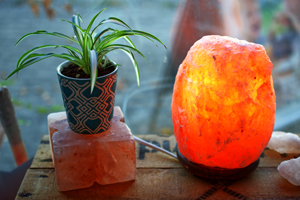The Science of Salt Lamps for ADHD

Himalayan salt lamps, with their rosy pink glow from a tea candle or lightbulb, are lovely to look at and might even evoke a feeling of calmness. They are popular in spas and herb shops, and among people who are health conscious.
Fans claim the lamps can help to decrease the symptoms of some mental health conditions. But do any of those claims hold up?
What are salt lamps?
Salt lamps are large crystals of rock salt, often gathered from a source in the Himalayan Mountains or other sources of ancient sea salt from deep in the ground, including the western United States. Typically they come in shades of pink from minerals and other deposits within the salt. To make a lamp, a chamber is carved to insert either a candle or a small light fixture and bulb; the heat from those sources warms the salt, causing it to glow. The lamps come in various sizes and are often used as accent pieces in home décor.
Salt’s nature is to attract moisture, especially when warmed. It also has some antiseptic qualities. It could be argued that those two factors might serve to attract moist air and act as an air purifier, eliminating some impurities, allergens, and odors. However, the effects on air quality would be minimal.
The claim:
Some people believe salt lamps release negative ions that have the ability to improve focus and concentration for people nearby. Based on that idea, there have been claims in some blogs and other online comments that a salt lamp will help to decrease the symptoms of ADHD.
The research:
There is little scientific research on how the presence of a warm salt lamp might affect the symptoms of ADHD. Researchers have studied the impact of machine-generated negative ions on depression and seasonal affective disorder but have not examined salt lamp-generated ions and ADHD symptoms.
Columbia University Medical Center’s department of psychiatry asked one of its experts about the benefits of salt lamps for improving mental health.
“There’s no evidence for it,” says Michael Terman, PhD, a professor of clinical psychology. “The ions emitted by activated salt are completely different from the negative air ions from a clinically tested apparatus that produces superoxide, and which may act via enhanced blood oxygenation. In Columbia University clinical trials, high-density negative air ionization produced an antidepressant effect far superior to low-density ionization (the latter being typical of home air purifiers).”
When negative ions have had a positive effect on mood, it has been in a controlled clinical situation using precision machinery to generate negative ions:
Air ions and mood outcomes: a review and meta-analysis. A literature review of 80 years of media and scientific literature on the psychological and mental health effects from ions in the air. ADHD is not specifically identified in the study, but the effects of negative ions on depression, anxiety, mood states, and subjective feelings of mental well-being were evaluated. Researchers concluded there was not any “consistent influence of positive or negative air ionization on anxiety, mood, relaxation, sleep, and personal comfort measures that was observed. Negative air ionization was associated with lower depression scores particularly at the highest exposure level. Future research is needed to evaluate the biological plausibility of this association.”
The conclusion:
Could having a salt lamp in the home or near a work station be a complementary approach for some people in addressing their ADHD symptoms? Here are some considerations in answering this question:
- There are no studies examining salt lamps and ADHD. The available research provides some peer-reviewed research for conditions that often co-occur with ADHD.
- Ions generated for these studies are created using clinical devices and not passively by salt lamps. They are not scientifically comparable.
- With clinical devices, researchers saw possible improvement for the symptoms of depression but not on the symptoms of other co-occurring conditions.
- Research during the past 80 years has not seen consistent results in experiments that use ions to alleviate symptoms. Without consistency, researchers are unable to know conclusively if ions improve mental health.
Salt lamps can add beauty to a room, and their soft glow could help some people feel more at ease. Given the lack of research available on the health benefits of salt lamps, and that the research on machine-generated ions for mental health shows limited benefit for depression, salt lamps may not be helpful in addressing the symptoms of ADHD and cannot be suggested as a complementary intervention.
Interested in other complementary supports for the ADHD lifestyle?
- ADHD Quick Facts: Complementary Interventions for ADHD
- Your Lifestyle Will Determine Your Future
- Why Look for Complementary Approaches?
- A Fishy Idea: Omega-3 Supplements as a Replacement for Medication
- Complementary and Alternative Treatments–a chat with Stephanie Moulton Sarkis, PhD, NCC, LMHC
- Watch: What else can I do? Complementary approaches to ADHD treatment
Do you enjoy the glow of a salt lamp? Share your experience with our community.
